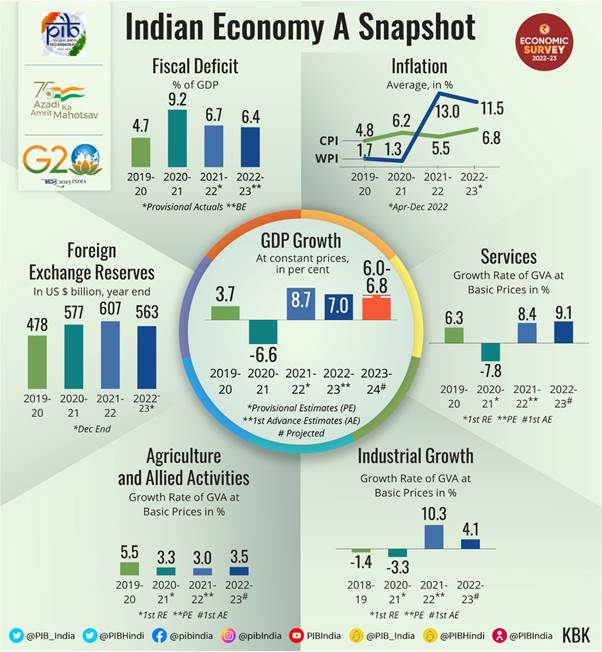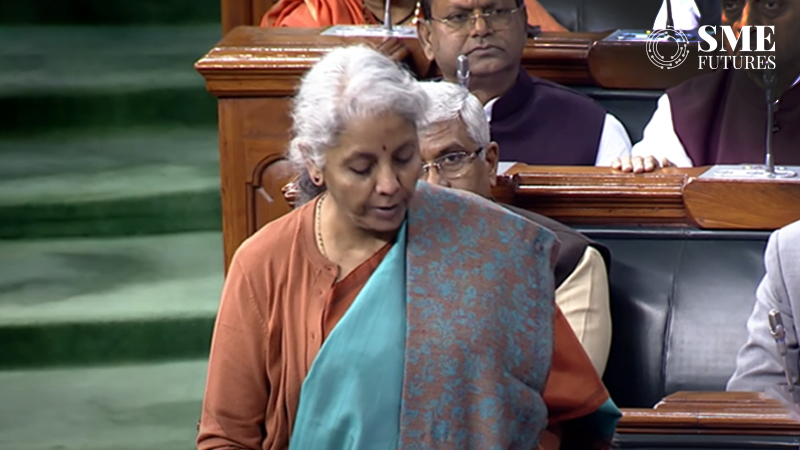India’s economy is projected to slow to 6.5 per cent in the fiscal year starting April but will remain the fastest growing major economy in the world as it fared better in dealing with the extraordinary set of challenges the globe has faced, said the Economic Survey 2023.
India’s gross domestic product (GDP) growth of 6.5 per cent in 2023-24 compares with an estimated 7 per cent expansion in current fiscal year (April 2022 to March 2023) and 8.7 per cent in the previous year.

Like the rest of the world, India too faced an extraordinary set of challenges in tightening financial conditions and supply chain disruptions from a prolonged war in Europe but “withstood them better than most economies”, the annual document detailing the state of the economy said.
The survey tabled in Parliament by Finance Minister Nirmala Sitharaman, stated that India is the world’s third largest economy in PPP (purchasing power parity) terms and fifth largest in terms of exchange rate.
“Economy has nearly recouped what was lost, renewed what had paused, and re-energised what had slowed during the pandemic and since the conflict in Europe,” it said.
While it indicated that inflation may not be too worrisome, borrowing costs are likely to remain ‘higher for longer’ as an entrenched inflation may prolong the tightening cycle.
Also Read: Budget wishlist: Economy can touch $5 tn if lives of farmers improve
India’s recovery from the pandemic was relatively quick, growth to be supported by solid domestic demand, pick up in capital investment, the Survey said but highlighted the challenge to rupee with the likelihood of further interest rate hikes by the US Fed.
Current account deficit or CAD may continue to widen as global commodity prices remain elevated and because of strong economic growth momentum. If CAD widens further, the rupee may come under depreciation pressure, it said, adding the overall external situation will remain manageable.
On exports, it said the growth moderated in the second half of current fiscal. Slowing world growth, shrinking global trade led to loss of export stimulus in the second half of the current year.
Pegging nominal growth at 11 per cent for 2023-24, the survey said the growth in the financial year beginning April 1 will remain strong relative to most global economies, led by sustained private consumption, a pick-up in lending by banks and improved capital spending by corporations.
The optimistic growth forecasts stem from a number of positives like the rebound of private consumption giving a boost to production activity, higher capital expenditure, and near universal vaccination coverage enabling people to spend on contact-based services such as restaurants, hotels, shopping malls and cinemas.
The return of migrant workers to cities to work on construction sites leading to a significant decline in housing market inventory is also a factor for the optimistic growth projection, it said.
The strengthening of the balance sheets of corporates, well-capitalised public sector banks ready to increase the credit supply and the credit growth to micro, small and medium enterprises (MSME) sector have also helped.
The survey said the growth is expected to be brisk in FY24 as a vigorous credit disbursal, and capital investment cycle are expected to unfold in India with the strengthening of the balance sheets of the corporate and banking sector.
Further support to the economic growth will come from the expansion of public digital platforms and measures such as PM GatiShakti, the National Logistics Policy and the production-linked incentive schemes to boost manufacturing output.
Also Read: Union Budget 2023: Indian auto industry pins hope on government to rev up e-vehicle market
India’s economy has rebounded since the COVID-19 pandemic, but the Russia-Ukraine conflict has triggered inflationary pressures and prompted central banks, including India’s, to reverse the ultra-loose monetary policy they adopted during the pandemic.
The survey stated that the inflation projection by RBI at 6.8 per cent for current fiscal (FY23) is above the central bank’s tolerance limit but the pace of price increase is not high enough to deter private consumption or low enough to weaken investment.
According to the survey, the pressure on the Indian rupee could continue due to the tightening of monetary policy. CAD may also remain elevated as imports could remain high due to a strong local economy while exports ease due to weakness in the global economy.
India’s CAD was 4.4 per cent of GDP in July-September period, higher than 2.2 per cent a quarter ago and 1.3 per cent a year ago, as rising commodity prices and a weak rupee increased the trade gap.
The survey said there has been an improvement in employment conditions in India due to stronger consumption but a pick-up in private investment is essential to creating more jobs.











